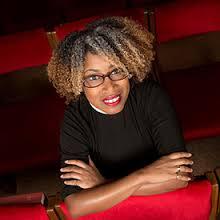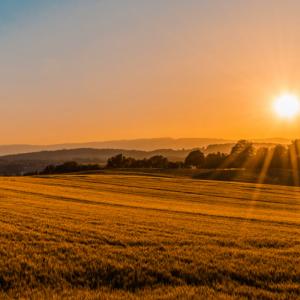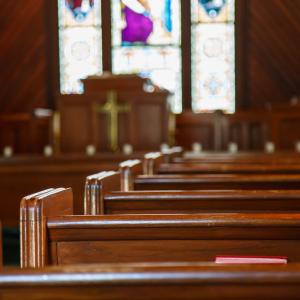
Rev. Dr. Wil Gafney is associate professor of Hebrew Bible at Brite Divinity School and an Episcopal priest.
Posts By This Author
The Long Green Season
THIS MONTH'S LESSONS FOCUS on the created world: sabbath, so that we might live in harmony with the created world; physical bodies, with which we experience the created world; creation as the locus of redemption, where the reign of God roots into the earth; and creation as the locus of revelation, where the majesty and mystery of God are made manifest.
In North America we are heading into what is traditionally the hottest part of the summer. The church, meanwhile, is going through the long green season, signifying the growth of the church after the explosion of Pentecost. While we care for the institutions of the church and the souls that make up the church, let us not neglect the earth that bears all of us and our institutions.
What might it mean to read each text with a keen awareness of the ways in which earth, land, and creation appear as characters and setting for the passage? What might it mean to attend to how human characters interact with earth, land, and creation? It may be possible for the church to get beyond the binaries that exalt spirit over body and church over earth/world. It may be that we are able to hear a call to tend the earth as part and parcel of caring for the souls that are on it—not as a competing agenda.
[ June 3 ]
Keeping Sabbath
Deuteronomy 5:12-15; Psalm 81:1-10; 2 Corinithians 4:5-12; Mark 2:23-3:6
IN MARK 2:27, the Sabbath is God’s gift to humanity, but first it was God’s resting space or place in Genesis 2:2. In resting, God sets a holy example for us that would be elevated to a command (Exodus 20:8; 31:14,16). Deuteronomy is a reiteration of the Torah and chapter 5 nearly duplicates the Ten Commandments from Exodus 20. In Mark, keeping the Sabbath is articulated as divine requirement. It’s almost as if we hadn’t figured out that sabbath was a good gift, good for us, and that we were required by our heavenly parent to take that rest, like a toddler being put down for a nap.
I find it useful when teaching Christians to distinguish between keeping the Sabbath and keeping a sabbath. My translation of our Deuteronomy passage is: “Observe the Sabbath day and keep it holy, as the Holy One your God commanded you. Six days you shall labor and do all your work. But the seventh day is a sabbath to the Holy One your God; you shall not do any work ...” Christian celebration of the resurrection on Sunday is not the same thing as Sabbath-keeping—particularly for those of us who are clergy. The Sabbath is the seventh day; it is not a moveable feast. “Sabbath” and “seven” are forms from the same root word.
Curb Your Imperial Impulse
MANY OF THE VOICES in this month’s readings seem to have “no filter.” They say what they think without adjusting it for politeness or theological correctness. In so doing, biblical paragons are presented as identifiably human, and God is seen as a God who welcomes our unvarnished truth. Here the raw human emotion acknowledges the complex terrain that is the human heart. The texts assume we feel, hurt, and occasionally want revenge; that we transgress and fear revenge; that we want forgiveness for ourselves but not necessarily for others. We can feel that God had gotten the better of us. Our experiences of God can be frustrating and painful. Like Jeremiah and Jonah here and Hagar (Genesis 16:7-14; 21:15-19) and Hannah (1 Samuel 1:9-11) elsewhere, these texts invite us to tell God about God and take our frustrations to God.
The scriptures call us to interpret them with regard to their ancient contexts and our contemporary ones. Israel/Judah, in any of its configurations, was one of the smallest and least powerful nations in its world. The scriptures were compiled and received their last edit when what was left of Israel was completely subjugated by a foreign power. That is not our contemporary situation as Americans. We may have been conditioned to read from the position of Israel, but we also need to read from the position of empires that subjugate. If God can bear us without filters, surely we can scrutinize our own imperial impulses.
500 Years of Reading Deeply
THIS MONTH'S LECTIONARY includes very familiar texts, such as Psalm 23 and the command to love one’s neighbor as oneself. With these passages comes an opportunity to read them from a fresh perspective. It is tempting to read individual verses with reference to ourselves and our contemporary circumstances; indeed, that is the only way some read the texts. However, the cyclic nature of the lectionary provides regular opportunities to engage these texts from different perspectives.
October marks the 500th anniversary of the Protestant Reformation, which revolutionized the way many people gained access to the biblical texts, newly translated out of Latin and into their own language. The Reformation put a high value on a believer’s access to the scriptures, which is now easy to take for granted. The translations produced during the period of the Reformation signified a deeper journey into the scriptures – and not just for scholars.
Bearing this in mind, what might reading more deeply look like for those who are not biblical scholars? Most if not all of these texts were composed to be read aloud. These texts often “read” quite differently when heard aloud. Perhaps the most important question we can ask of a text is how it was understood in its originating context, recognizing the differences between our world and the worlds of the Bible. Lastly, it is essential to ask how the message of a particular passage functions in our world, particularly when some of its framework reflects values we no longer share.
Growth Can Take Generations
GOD'S FAITHFULNESS is measured in generational time. An emphasis on God’s faithfulness across generations is, by necessity, also an emphasis on community. God speaks and acts for the benefit of those present and those to come. Even when singular figures are mentioned—a prophet, a monarch—the message affects and is passed to and through the people.
The law and prophets represent God’s investment over time and bind together these readings. The law and prophets speak at moments in time but their messages are timeless. The gospel presents these truths embodied in the person of Jesus—and the epistles preach them passionately.
These lessons are read in the great expanse of liturgical time known as “ordinary” or as the season after Pentecost. This is a green season in the church (no matter what your grass looks like); that green symbolizes growth. This is a time for remembering the explosive growth of the early church and tending to our own growth as individuals and in community. Growth takes time. Our sacred stories make abundantly clear that the people of God—individual exemplars and the community, nation, and church—grew into fidelity over time.
The shaping of character and growth of faith is a process. These texts are signposts along the way.
Rumors of Life
EASTERTIDE IS IN FULL STEAM—heading toward the culmination of Pentecost. This is a season of holy rumor: “He is not dead.” “I know someone who saw him.” “My brother touched him.” “He was right here on this shore.” “He just walked through the wall.”
Those holy rumors fanned the flames of a transformed and transforming faith. It is easy to forget that the rumors of Jesus’ resurrected life went against some pretty powerful evidence: his public shaming and crucifixion, the continuing dominance and oppression of the unholy Roman Empire. At one level, nothing had changed; at another, everything had changed.
We remember, commemorate, and live into the resurrection waiting for the redemption and resurrection of all creation in a world in which it looks like nothing has changed. But there are these holy rumors, insistent whispers, and raised voices that do not care who is listening. There are rumors of life that transcend death. Even without first-hand witnesses in our time and against all the evidence, the church affirms the witness of the women who saw and proclaimed the risen Christ.
We still assemble, a church made up of many nations, waiting for the outpouring of the Holy Spirit to rekindle the embers of the holy faith that survives the empire’s best effort to extinguish it. The rumor is that God’s people will survive the present age and its empires, all evidence to the contrary.
Resurrection Spaces
THE WHOLE CHRISTIAN YEAR stretches toward this moment when we reach back to acclaim the power of God over death manifest in the resurrected life of Jesus. The passion and pageantry of the days from Palm Sunday to Easter Sunday enable believers to mystically live in the ancient moments we commemorate. At the same time, we are very much present in a world that is anything but resurrected; it is, as I often preach, “crucified and crucifying.” It is easy to find the broken places in our world and those that deal death. Where are the resurrection spaces? Where do we look to see that death does not, in fact, have the last word? What is our work in bridging the gap between death and life?
This month’s lessons brim with passionate faith on Jesus and his triumph over the grave. These accounts stem from nearly a century and more past the events that inspire their faith. The authors and editors of these texts also lived in a world in which the triumph of the resurrection was not apparent in many aspects of their lives; many went to gruesome deaths confident in the resurrection despite the power the empire wielded over their mortal lives. To strengthen our faith, they left us the accounts in the scriptures we read in this season. But we are not dependent on their words. We have unmediated access to the love and power of the resurrected Jesus.
Stories in Conversation
AS THE CHURCH wends its way through Lent, the last days of Jesus become the focus of the lectionary. The story of those days is hopelessly entangled with the story of the early church establishing and defining itself. One consequence of this is the habit of the Johannine gospel (John 2:13-22) to blame “the Jews” for all that befalls Jesus. Its authors are a long way from Mark’s portrait of a Torah-observant Jewish Jesus (Mark 14:3-9). And yet John 3:16 proclaims the love of God for the world; no sibling rivalry can stand in the face of that love. Similarly, Jesus announces that he will draw all people to himself in John 12:32.
The epistles emphasize that Christ calls all, non-Jews (lumped together under the moniker “the Greeks”) and Jews, in 1 Corinthians 1:18. The emphasis on God’s love and mercy in Ephesians 2:4 makes this reading especially suitable for Lent.
The readings from Hebrews and Philippians on the last two Sundays focus on a heavenly Christ who is exalted, in sharp distinction to the earthly Jesus betrayed and executed in the passion gospel.
This diversity of texts reveals Jesus through the different lenses of his faithful at varying points in the church’s story, inviting us to add our vision and voice to the telling of that story.
[ March 4 ]
Exodus 20:1-17, Psalm 19; 1 Corinthians 1:18-25; John 2:13-22
THE TEN COMMANDMENTS spell out human responsibilities in the covenant between God and Israel, and subsequently to us, who have become party to that covenant. Not surprising, the commandments that pertain directly to God precede those that pertain to sister and brother human beings. The commandments are presented as being on the very lips of God. It is not clear whether God speaks through Moses or directly addresses the people. (In Exodus 20:18, the people witness the lightning, thunder, and smoke that accompany God’s speech and ask God not to speak to them, raising the possibility that they saw but had not heard or didn’t want to hear further.)
Light and Shadow
THIS MONTH SEES several liturgical transitions. Epiphany, the season of light and revelation, comes to a close. Jesus’ transfiguration is its own epiphany. The church enters the season of Lent, beginning with a focus on human frailty and failure—and for many people an evening (or week) of indulgence in things that bring joy, pleasure, and sweetness. The light is still there, but we are peering more intently at the shadows.
The opening prayer for Ash Wednesday in The Book of Common Prayer begins, “Almighty and everlasting God, you hate nothing you have made and forgive the sins of all who are penitent.” The readings for the first week present the God whose power and splendor in creation is only matched by her care for her children. The radiance of the transfiguration also shines a light on the ways in which we are not like Jesus, yet he chooses to leave the mount of illumination and return to the world that needs his light. The readings for the third week attend to the world God has made, calling us to care for it in partnership with God. And on the final Sunday, Jesus teaches about his death and resurrection, the greatest transition in the scriptures.
The Church of Another Chance
THE NEW YEAR OFFERS an opportunity to take stock of ourselves and our intentions for our own well-being. Radical attempts at self-reformation often end in frustration, including attempts to develop new spiritual habits. This month’s texts hold a up a series of mirrors in which we can assess ourselves and see perhaps that we do not need to be wholly reinvented. The Spirit who weaves through the early texts is present at creation and through the life of Jesus, and she remains to guide us.
Whatever the new year brings, we will not face it alone. In the second week, we have an opportunity to speak frankly about sexual misconduct or choose to preach different aspects of the lessons. The new year offers an opportunity to do the hard work of community, protect the vulnerable, and hold accountable those who violate sacred trust. We do so knowing the Spirit does not shrink from the subjects from which we shrink. She will be there with us through the difficult work. Likewise, the third week’s readings offer an opportunity to do the hard work of repenting and asking forgiveness before we try to be reconciled to those whom we have wronged. This is particularly important for people who hold power and in religious settings where pressure is often put on those who have been wronged to forgive before they have begun to heal from their injury—or while they are still being harmed. The final lections invite us to sit and stand in awe of God and treasure the knowledge that comes from those postures.
Advent: A New Year
ADVENT MARKS THE BEGINNING of the Christian year, for many. We await the return of Jesus and prepare for it by revisiting the story of his first coming. In Isaiah 64, the prophet longs for God to tear the heavens and come down, a description more apt for the latter return of Jesus than his first appearance. The longing for Jesus to return and fix the world’s mess escalated for many last year about this time and was expressed by a widely read online Advent devotional under the hashtag F**kThisS**t. (The original title was unapologetically uncensored. The originators argued that “to convey a visceral gospel, we must sometimes use visceral language.”)
There is a theology that says one day God will clean house and fix everything. In the meantime, we have to live here. Advent is about waiting and preparation. What shall we do while waiting for the return of Christ? What can we do about the state of the world? The gospel for the second Sunday in Advent calls for spiritual work, confessing and repenting sins (Mark 1:4-5). The following week the gospel suggests that there is work to which we can put our hands: “Make straight the way of the Holy One” (John 1:23).
The Longest Season
IN NOVEMBER, the season after Pentecost comes to a close. The church has reflected on the power of its genesis and its spread outward from Jerusalem. The lessons now represent one last opportunity to review the fundamentals before returning to the story of Jesus from its inception. Several of these scriptures communicate the notion that time is running out. Others emphasize the knowledge of who we are in God’s sight and who we understand Jesus to be. The season that began with the power of the Spirit breathing a new creation into the world ends this month with an affirmation of sovereignty.
The psalms that weave through this grand story move from the personal prayers of a pious person to the worship of a grateful congregation. The prophets echo each other: God is going to call the world to account and God acts to preserve her people. The epistles confess the theology of the ancient church with an urgent zeal, allaying its fear and anxiety about what is to come. The gospels communicate their own urgency. Rather than simply preparing the church to abandon its earthly ship, the gospels call us into relationship with one another, to care for each other as we would care for Jesus in the flesh for however long we tarry here.
The coming seasons of Advent and Christmas are marked by an adoration of the Christ child. But this longest season on the church’s calendar bids us to love and serve the Christ that is hardest to see, the one hidden in the flesh of each other.
Speak!
Judges 19 is a story of intimate betrayal and the complicity of a larger community calling us to consider our own roles in our communities...The sheer horror of what this woman endured—including at the hands of husband and host—extinguishes the fires of my sanctified imagination. I can only conjure her screams. And I have no words to express them. One might look to God for a final word, but God is absent from the chapter, as this chapter and any mention of domestic violence is absent from too many pulpits.











